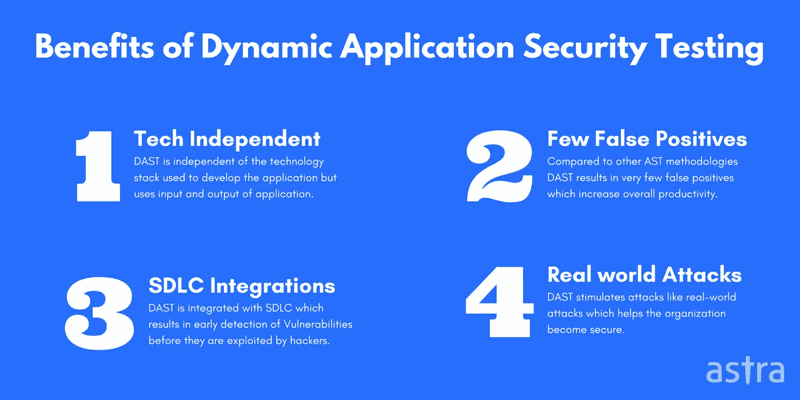There are many ways to protect your web applications with comprehensive security testing methods in today’s technology-advanced era. Dynamic Application Security Testing (DAST) is one of the best testing types that most organizations and security testers use to carry out security testing for their static and dynamic web applications and SaaS apps.

Dynamic Application Security Testing allows developers and testers to find vulnerabilities in their code before it’s released or deployed. This is a great way to increase security and reduce costs associated with fixing bugs after an application has been released. This post will go over what Dynamic Application Security Testing is and how it can help you protect your applications from hackers!
What is dynamic application security testing and how does it work?
Dynamic Application Security Testing is a type of web security testing that involves analyzing your code as it runs to find vulnerabilities, such as Cross-Site Scripting (XSS) and SQL Injection. Dynamic applications run on an interpreter or web server, including HTML pages, scripts, applets, etc. Dynamic web applications have become more popular over the years with the creation of technologies like Active Server Pages (ASP), JavaServer Pages (JSP), ColdFusion Markup Language (CFML), and PHP Hypertext Preprocessor (PHP).
How do I implement Dynamic Application Security Testing?
Dynamic Application Security Testing can be implemented manually using available tools for analysis. This approach requires advanced technical knowledge and the ability to test your applications. Dynamic application security testing can also be automated with a tool that will efficiently provide accurate results. With automation, Dynamic Application Security Testing becomes much easier for developers and testers – you only need to set up a customized scan policy according to what vulnerabilities exist within each page of your site/application.
How does Dynamic Application Security Testing benefit my organization?

Dynamic Application Security Testing provides several benefits, including early detection of security flaws, reduction in time spent finding bugs, increased code coverage throughout the development life cycle, improved user experience (UX) due to decreased coding errors or issues within web pages after they are launched on live servers; reduced costs associated with maintaining websites because there are fewer problems with the application. Dynamic Application Security Testing is a great way to increase security without spending too much time, resources, or money.
Cloud computing is an excellent approach to reduce costs while also increasing the speed and efficiency of your organization. If you employ cloud computing choices like GCP, you may create and host your business apps on Google Cloud Platform (GCP). GCP penetration testing will discover vulnerabilities and weaknesses in the GCP environment and will assist you in repairing such flaws, allowing you to improve GCP security.
What are some challenges associated with Dynamic Application Security Testing?
One of the biggest challenges when implementing Dynamic Application Security Testing is finding tools to scan your applications effectively while not affecting performance.
Another challenge for organizations using dynamic web applications involves identifying code issues that have already been developed and deployed – this requires manual testing by QA/QE teams or developers. They have extensive knowledge of Dynamic Applications.
Also, it’s important to note that Dynamic Web app testing cannot be used for functional tests – they must execute them manually since they focus on vulnerabilities only (compared with Functional Tests, less intensive).
Dynamic Application Security Testing is great for finding vulnerabilities, but it’s not a replacement for functional tests. Dynamic testing tools can be expensive and time-consuming to implement – these issues should be considered before making any decisions on Dynamic Application Security Testing.
Why should you use dynamic application security testing?
Dynamic web apps run on an interpreter or a web server, making them susceptible to attacks like Cross-Site Scripting (XSS) and SQL Injection.
Dynamic Web App Security Testing helps identify flaws that allow hackers access into your company’s systems through their website(s).
An attack may lead to stolen confidential data from your system, including usernames & passwords, financial information such as credit card numbers, etc.
Dynamic Application Security Testing helps companies protect their business data, customers’ privacy, and intellectual property.
Dynamic testing techniques can test web applications throughout the development life cycle – after every build or update.
Are there any alternatives to this process ?
Yes, Dynamic Application Security Testing (DAST) can be automated with a tool that efficiently provides accurate results. With automation, Dynamic Application Security Testing becomes much easier for developers and testers – you only need to set up a customized scan policy according to what vulnerabilities exist within each page of your site/application. However, if this isn’t an option, Dynamic Manual testing may work as well, depending on the resources available at your company or organization.
Conclusion
Dynamic Application Security Testing (DAST) is a powerful tool for improving the security of your applications. It can be used to detect vulnerabilities and other risk factors that could allow attackers access to sensitive information or disrupt operations. DAST provides an automated, continuous feedback loop with real-time results of scanning activities so you know what needs more attention as soon as it happens.

